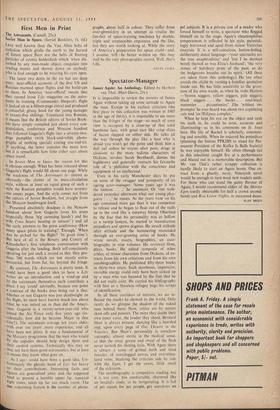, First Men in Print
The Astronauts. (Cassell, 25s.) LESS well known than the Van Allen belts of radiation which girdle the earth to the hazard of future space , fliers are the belts of floating Particles of cosmic balderdash which when dis- turbed by any man-made object, coagulate into reading matter and shower down on anybody Who is fool enough to be wearing his eyes open.
The latest two dents in the tin fiat are deep ones: near-official accounts of the first US and
• Russian manned space flights and the build-ups I, to them. In America 'near-official' means that they turned loose Life magazine on the astro- , aauts in training (Commander Shepard's flight Is tacked on as a fifteen-page extra) and produced a colourful, glossy book for the young teenager at twenty-five shillings. Translated into Russian, It means that the British editors of Soviet Book- lets have simply compiled just about every con- gratulation, conference and Moscow handout that followed Gagarin's flight into a seventy-two- Page pamphlet (with black-and-white photo- graphs of nothing special) costing one-and-six. If anything, the' latter contains the more text. but it is remarkable how little either says about space travel.
In Soviet Man in Space the reason for this Is obvious enough. What has been released about Gagarin's flight would fill about one page. While the weakness of The Astronauts is—almost as obviously—the clutter of its mass-circulation style, without at least an equal grasp of such a style the Russian pamphlet would have seventy- one empty pages. And the style comes not from the editors of Soviet Booklets, but straight from the Moscow bandwagon itself. Presented absolutely deadpan is the Moscow handout about how Gagarin loves his mum (especially those 'big caressing hands') and his Wife ('two hearts beating in unison!)- and all the curly answers to the press conference (How Many space pilots in training? 'Enough.' When Was he picked for the flight? In.good time.'). But best of all is the Boxery and Coxery of Khrushchev's first telephone conversation with Gagarin after the landing. Both self-consciously sPeaking for just such a record as this. they pro- duce 700 words which are not merely extra- terrestrial, but from, far, far beyond the fringe.
By contrast, The Astronauts is pretty tame. It Could have been .a good idea to have a Life Writer do an introduction and a wind-up and let the astronauts themselves each contribute a Piece. 1 say 'could' advisedly, because one point a contrast of the books does bring out is that, Whether or not Gagarin was just deadweight on his flight, he must have known much less about What he was mixed up in than did the Ameri- cans. Gagarin is a twenty-seven-year-old who Joined the Air Force only five years ago (in- cidentally, how did he become Major in that time?). The astronauts average ten years older. with over ten years' more experience, and all have been test pilots. It was a fundamental of the Mercury programme that the men who would fly the capsules should help design them and their control systems. l echnically this may or !nay not have been good astronautics, but at least It means they know what goes on. As I say: could have been a good idea. Un- fortunately the ghostly hand of Life lies heavy On their contributions. Interesting facts and figures are generalised away and the supposed need to present a humble upper lip, repeated eight times, takes up far too much room. The one redeeming feature is the number of photo-
graphs, about half in colour. They suffer from over-gimmickry in an attempt to vitalise the fun-fair of space-training machines by double, triple and umpteenible exposures and the like, but they are worth looking at. While the story of America's preparation for space could—and, assume, will—be better written up this may well be the only photographic record. Well, that's Life.
GAVIN LYALL






























 Previous page
Previous page